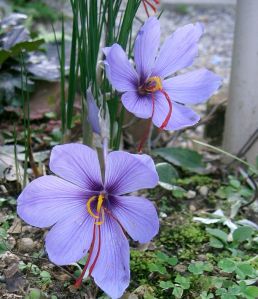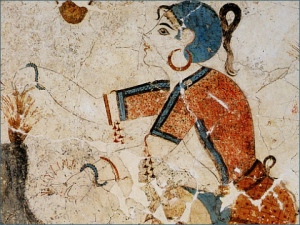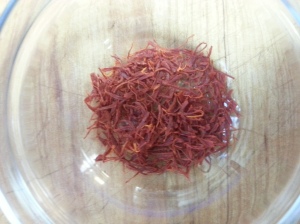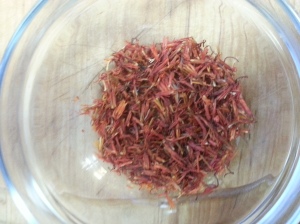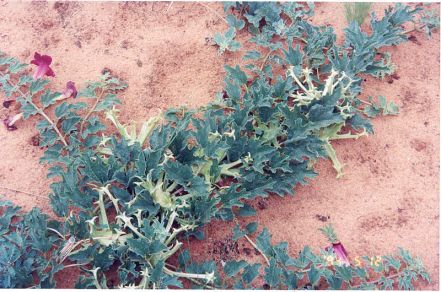Life, is chaotic as usual! I have a lot of sewing projects (a lot) along with a lot (seriously too many) of migraines (so many it took way too long to finish this post). Time to sit and write feels so precious these days, and this post took way longer than I wanted to get out. But, without my writing I don’t feel whole – so I make time! ( >_<)9
The Hubs is growing a beard, seems to be all the rage these days with the male of our species in my age group. He went to get a shave and a haircut at a local place and they put some oil on his beard for conditioning it. He loved it, and I thought it smelled really great! Like cut wood and lovely (he would probably disapprove of that term but who cares 😉 ). So we looked up the ingredients, because I wanted to make it for him – like I love to do, and of course one of the ingredients was sandalwood – the others were pine and cedar wood with some hair friendly carrier oils, (remember rosemary is good for head hair, it is light and won’t weigh it down). Sandalwood had popped up in my saffron post, and I was growing more curious about it after reading some snippets here and there about it. So the dive into research began!
History and Uses of Sandalwood
Wow.Who knew that sandalwood was so cool? Well most of ancient India that is for sure! I love the stories surrounding the Gods and Goddesses of India, Durga, Sarasvati, and Lakshmi are personal favorites. So imagine my happiness when I found out that Sandalwood is sacred to that lovely Goddess Lakshmi! She is thought to reside in the wood itself, as mentioned by the Brahma Vaivarta Purana.
The name Sandalwood comes from a corruption of the sanskrit word Chandam, which then evolved through linguistic corruption into Sandal possibly along the path Chandam → Sandanam → Sandalum → Sandal. Chandam could mean literally “wood for burning incense” or “shining, glowing” from candrah. Most likely the word we use today is from a late Greek word – santalon – which probably influenced Medieval Latin to create sandalum which then led to sandell in Old French and then sandal in modern English.
All sandalwoods are what is known as a hemiparasite which Wikipedia defines as –
“a plant that is parasitic under natural conditions and is also photosynthetic to some degree. Hemiparasites may just obtain water and mineral nutrients from the host plant. Many obtain at least part of their organic nutrients from the host as well.”
Sandalwood is very similar, as well as related, to the well known mistletoe. While they do photosynthesize to create their own food, many of the species also have a taproot that seeks out other plants and then feeds from them. Sandalwood has a sad story of destruction and overuse by humans, so it is extremely important to not only check for the species of sandalwood used in an oil, but also that it is sourced in a sustainable and ethical way. Generally the more expensive the sandalwood oil is, the more likely it is of the right species and from a legit harvester that is approved by the Indian government. Since it is so endangered in the wild there are strict harvesting rules and regulations around sandalwood trees. Sandalwoods are very slow growing trees, which makes restoring the wild population difficult when illegal harvesting is happening. And the older the tree the better quality and stronger smelling the oils (and wood will be).
It’s scent is what makes it so alluring, and I know well of this. My parents lived in China right before I was born, and I had a lot of unusual things growing up. One of them was a carved sandalwood fan, it was so delicate and I would take it out of its little protective box to just sit and smell it.

My fan looked much like this sandalwood carved fan
The scent was just so addictive to me even then, and I think this scent is what has drawn humanity to it over the centuries. It is also used in a lot of religious carvings from prayer beads, to statues of gods and goddesses, to even little fans like mine.
Sandalwood has a large part in human history as well as religions. Sandalwood is mentioned in Indian texts for at least 2,000 years and was used for religious practices as well as medical uses for possibly up to 4,000. It is basically a huge part of life in Hindu culture, it is used in birth rituals, marriage ceremonies, and death rituals. It is used in its oil form, and the wood is used in a powdered form and both are used for the aforementioned religious and medicinal reasons – which I briefly mentioned in the saffron post since it is great for skin masks, soaps, and other preparations, and helps treat and reduce acne as well as other skin conditions. It was also very prized for religious carvings, and for other carved wood products since it retains its scent for decades. In Hinduism specifically it is used as a paste, which is mixed with saffron or other herbal pigments, and is called chandan. Chandan is sacred and can only be prepared by those who are ritually pure. The paste is then used by devotees and is put on the forehead, neck or chest in a ritual manner. Chandan can also be mixed with herbs, or other items to create javadhu which is generally used as a perfume or mixed with water to make a paste and used as deodorant.
Typical Javadhu powder you would find in a store
In both Hinduism and Ayurveda sandalwood is a very holy, and thought to bring one closer to the divine (hence its use as a ritual paste) in fact it is one of the most holy elements to Hindu practitioners or followers of the Vedas and sometimes applied before prayers.
In Buddhism it is also mentioned in some of the sutras (or sutta, depending on which flavor of Buddhism you follow), specifically the Pali Canon mentions it. There is even a legend that as the Buddha died, sandalwood powder fell from the heavens. Sandalwood is thought to be of the lotus (padma) group for the Amitabha Buddha, and is considered one of the three main incenses that are integral to Buddhist practice in general. Sandalwood is thought to focus the mind, and keep one alert during meditation, as well as transform “desires.” It is the most popular for offering incense to oneself in Buddhism.
In the Sufi tradition of Islam sandalwood paste is applied to the grave of a saint by devotees, a mark of respect and of devotion – mostly practiced by people in Southern India where Tamil culture has an influence. In Chinese and Japanese local custom it is also a common incense used in worship and other ceremonies. In Zoroastrianism (in which fire is very sacred) the priests, Mobads, that keep the fire offer it sandalwood – but it is not used in home offerings to the sacred lamps kept in the home. Sandalwood purchased in a fire temple is often more expensive than elsewhere since it is a common form of income for the temple and the Mobads.
Why and How it Works
Some of the chemicals you can find in sandalwoods are santalin (which provides the red color for dying), santene (a terpine that is also in pine needles), tannic acid (same stuff you get in wine!) and santalols. The main chemical that is important in sandalwood for medicinal use is santalol.

Alpha-Santalol in its chemical format
Which is broken into two different chemicals α-santalol and β-santalol. Alpha seems to be the most common chemical, but seems like the beta version is the most medicinally useful. It is pretty hard to find medicinal journals that speak of trials and uses of santalol in medical tests but there is a mention in a medical journal of pharmacy ….from 1911. Though it is useful since it points out that sandalwood oil is not very pleasant in taste (though I, personally, would not suggest taking this internally). There is a lot of anecdotal evidence that there are antiseptic, anti-inflammatory, antispasmodic, astringent, slight sedative, and good for the respiratory system, hair, and skin. The German government has approved sandalwood oil as a treatment for urinary tract infections, so there is at least some scientific evidence that it is effective for treating infections, but other than that official scientific studies are very scarce. The most interesting point of the German studies is that the oil needs to be coated so that the oils are not released until it hits the small intestine – or it could cause irritation. For this reason I again – do not advise taking this internally.
There seems to be some evidence of its anti-inflammatory action again no firm scientific trials but there is a ton of folk medicine and word of mouth evidence to back this up. Same with the antispasmodic but, again not nearly enough evidence scientifically to completely back these claims, but 4,000 years of history must have something to it. I have found that its use helps with pain, and spasms – especially when massaged into a painful area (with a carrier oil, this tends to need to be diluted). I have not tried it personally as a sedative, though I find the scent quite soothing. It’s antiseptic properties make it a fantastic addition to deodorant since it helps to kill any bacteria that would be lurking around in your armpits. Its skin properties help with scar treatments (like lavender does) and helps soften and soothe, and helps sooth skin inflammation as well as things like eczema. Its astringent nature as well as its antiseptic, make it also great for treating acne. It also helps soften hair, and moisturize it, so it is great to apply to hair on your head (like rosemary, though it is not as light as rosemary) or hair on your face (if you’re a guy 🙂 ).
Floral scents like lavender or geranium blend well with sandalwood, as well as clove, bergamot, vetiver, and black pepper.
Sustainability & True Species
Like all things that are expensive – saffron, cinnamon and frankincense are good examples – sandalwood oils can be adulterated or diluted at the cheap end of the spectrum. And the actual stuff is expensive – like Lemon Balm oil level which makes frankincense look cheap! I found that it is actually one of the most highly adulterated oils for sale on the market. That means if you see a 9-13$ bottle – you are probably getting mostly jojoba oil or some other carrier oil – or not even a drop of real sandalwood oil. Real sandalwood oil (Santalum album) is in the 100$+ range, which is really prohibitive for some pockets. So you can purchase the cheaper stuff, and this is the cheapest one I trust using on my skin. If you want to go “whole hog” I would go with this site or this one (which also has powdered sandalwood) since they are sustainably and ethically harvested. As you can see the cheapest one is actually a blend of species, since they are all technically all sandalwood but not the “top” species (though they are all good species in the blend as we will discuss further down).
This is another one of those “you get what you pay for” type things. Like the cinnamon I mentioned – if it is cheap, it probably is cassia. Once you have had true cinnamon, there is nothing like the real thing! But what is the right species of sandalwood? Well you could make a blanket statement like all trees of the Santalum genus are real sandalwoods. Which would mostly…mostly be true.
But there are a few main species used for sandalwood that you should be familiar with and are the most commonly used.
Indian Sandalwood – (Santalum album)

Santalum album
Other Common Names – White Sandalwood, East Indian Sandalwood, Chandana, or Chandam
First up is the king of all sandalwood species (or would it be queen?) either way Santalum album is the one that is most commonly used, and is sadly the most threatened of species due to poaching and illegal logging. Also this is the wood that sandalwood is named from since Chandam is the Sanskrit word that led to the modern English word. This species is currently the most vulnerable to extinction in the wild, which you may have heard of due to the exploits of Veerappan, a well known sandalwood smuggler. Often used in religious carvings, and as a powder (then made into a paste) is smeared on devotees or made into incense. It is also used for folk medicine and was used to treat: common colds, bronchitis, skin disorders, heart ailments, general weakness, fever, infection of the urinary tract, inflammation of the mouth and pharynx, liver and gallbladder complaints and other maladies. It is known to be effective (from folk medicine history and some medical trials) in treating analgeisc (specifically calming to nerves), antidepressant, antifungal, antispasmodic, antiviral, astringent (good for acne and skin), sedative and a fantastic scent to add to perfumes, soaps, and deodorants.
Coast Sandalwood – (Santalum ellipticum)
Other Common Names – ʻIliahialoʻe, or Hawaiian Sandalwood
Hawai’ians used the heartwood (‘la’au ‘ala) for its oils, and was often exported to China during the years 1790-1840 for production of carved objects, chests, and joss sticks (incense). The natives used the wood to make the decks of their double hulled canoes (wa’a kaulua) and the heartwood was used to make perfumes and sometimes added to kapa cloth possibly for its fragrance. The leaves and bark were used after burning to ash to treat dandruff and head lice. Shavings of the wood in combination with other plants were used to treat some sexually transmitted diseases.
Australian Sandalwood – (Santalum spicatum)
This is a species that comes from Western Australia, and its export is a major part of their economy. Its oil was first distilled in 1875, and was produced here and there for a few decades until the 1990’s when it experienced a resurgence which increased (and is still increasing) since it is often used in the perfume industry, very popular with aromatherapists, and in chewing tobacco. This is a much less threatened species, and is almost equal in medicinal properties to Santalum album without the worry of using an extremely endangered species. So if you are unable to afford or can not find ethically sourced Santalum album, this is a good (and less costly) alternative. Testing shows pretty strongly, so far, that it has a lot of great antimicrobial properties, as well as all the stuff listed for Santalum album (since they are so closely related their chemical makeup is very similar and makes it a fantastic stand-in for the more expensive sandalwood).
Other Santalum species you may see are: S. acuminatum, S. austrocaledonicum, S. boninense, S. fernandezianum, S. freycinetianum, S. haleakalae, S. lanceolatum, S. macgregorii, S. murrayanum, S. obtusifolium, S. paniculatum, S. yasi. These species you may see pop up in the occasional commercial preparation, but are not commonly used nor are their medicinal properties well known.
The Fakes
These species, while useful in their own rights are not sandalwoods and are occasionally used as an adulterant in real sandalwood oils or preparations. These should be avoided if you are looking for a real sandalwood.
- Adenanthera pavonina sometimes called Red Sandalwood, but this is not sandalwood. Its seeds while toxic when eaten raw are safe to eat when cooked and have been used to treat inflammation in folk medicine.
- Amyris balsamifera – known as Balsam Torchwood this is a common species accepted by a lot of perfumers and aromatherapy blends.
- Baphia nitida called African Sandalwood Camwood or Barwood, its bark and heartwood make a red dye, it is known as Osun in Yoruba and is a part of a brand of Nigerian black soap called Dudu Osun.
- Eremophila mitchelli also called False Sandalwood, Sandalbox and Rosewood Belvory as well as other common names. While native to Australia it is considered an invasive species in some areas of Australia and is illegal to plant.
- Myoporum platycarpum sometimes called Sugarwood, False Sandalwood as well, which is another native of Australia but is mostly toxic and just the sap is edible, but can not be produced by wounding the tree.
- Myoporum sandwicense another False Sandalwood, or Bastard Sandalwood, Naio in the native Hawai’ian. It was used in making canoes, fishing net spacers and torches for night fishing. It is a very oily wood and was part of the woods exported to China for Joss stick production.
- Osyris lanceolata known as African Sandalwood as well, but is generally in Southern parts of Africa, it is over logged despite government protection. Its wood is used for utensils and firewood, and in some communities it is used to preserve milk in gourds for long periods of time.
- Osyris tenuifolia or Osyris lanceolata known as East African Sandalwood or again as False Sandalwood. Not much information is available on this species.
Recipes
Easy Sandalwood Lotion
- 2 oz Coconut Oil
- 10-20 drops of Sandalwood oil (or 1/2 teaspoon of Sandalwood powder)
Take the coconut oil, and whip 2 oz of solid at room temperature coconut oil in a stand mixer with a whisk attachment, and adding 10-20 drops of the essential oils. You can also use a bit (half a teaspoon to a teapoon depending on how thick or honey-like you want your lotion. Raw honey is good wound healing and for your skin too.
You can also just add a drop or two of Sandalwood essential oil to your regular routine, or just massage a little into problem areas with a carrier oil (Sweet Almond oil is a good alternative if coconut oil makes you break out).
Saffron & Sandalwood Lotion
- 1/4 cup Whole almonds
- 1/4 cup Strained Yogurt (or Plain Greek yogurt)
- 2 teaspoons Lime or Lemon juice
- pinch of Ground turmeric
- 1/2 teaspoon Sandalwood
- pinch of Saffron
First make your strained yogurt, if you don’t know how to do this go here and follow the instructions. Then soak the almonds in a bowl of water overnight, peel the skins off the next morning and grind into a fine paste in a food processor or strong blender. Add in the strained yogurt, lime (or lemon) juice, turmeric, sandalwood, and the saffron threads. Blend again in the food processor or blender until smooth and creamy. This cream can be stored in a clean container in the fridge for about a week, and you should apply it after washing your face at night. Smooth it all over your skin and massage in gently, in the morning wash your face again.
Both of these lotions are good for fighting acne, skin rashes, eczema, sunburns, helps reduce age spots and brighten dull skin. It even does a lot if you massage it into scars, helping to soften them and reduce their visibility, you can even add in a bit of lavender too to help with the redness of scarring if you are treating that. Really it does your skin good and will help just about anything to do with skin 🙂 there is some evidence even that it may help with Rosacea, though it may irritate some skin types that have Rosacea so make sure to do a test patch before you attempt to treat it with sandalwood oil.
Sandalwood Steaming
- 2-5 drops Sandalwood oil
- Bowl of hot water, must be steaming
- Towel
Place a few drops into the bowl of hot water, place towel over your head and allow the steam to bathe the face. This another way to treat skin issues, or to treat very dry skin, or chapped skin.
ProChestColdTip: If you have a chest cold or respiratory issues, or even laryngitis, you can do this with some eucalyptus since there is some evidence that sandalwood can act as an expectorant and has antiviral properties.
ProStressTip: This can also be really good for stress, as the smell is very soothing, and has a mild sedative action, but I would suggest using meditation while inhaling the scent of just the sandalwood oil to reduce stress and bring relaxation.
Woodsy Beard Oil
- 25 milliliters Carrier oil (this can be straight or a blend, 100 drops = about 5 ml)
- 2 milliliters (about 50 drops) Sandalwood oil
- 1 milliliter Cedarwood oil
- 2 milliliters Pine oil
Mix well and store in a dark bottle, apply a few drops to hands and massage into beard. Comb through with beard brush or beard comb. Trust me guys your ladies will love this
The carrier oil can be anything you like, jojoba is good, vitamin E is great, argan oil is all the rage these days. Grapeseed, hemp, coconut, sweet almond, olive and apricot are all ok as well – it is really up to you on this and what works best with your face and hair and you can combine them and do half and half, or whatever combo you prefer most. Since you will be putting this on your face it will condition and soften your skin (especially with sandalwood oil) and condition and soften your beard hairs. This will make about an ounce, and you can either use a bottle with a dropper or you can use a bottle that has a built in dropper like on most essential oil bottles. You can even re-use some essential oil bottles for this.
ProScentsTip: You can also substitute the pine or cedarwood for lime and rosemary respectively, for a more citrusy smelling oil. You can also check out this site which has some great links for bottles, measuring equipment (if you don’t have anything to measure milliliters with) and some other recipes.
Muscle Spasm Massage Oil
- 1 ounce Carrier oil
- 10-20 drops Sandalwood oil (or 1/2 teaspoon Sandalwood powder)
- 10 drops Wintergreen
- 10 drops Cardamom
Mix well it is best to use an oil that is liquid at room temperature, if you use coconut oil that is not, you may want to whip this in a stand mixer to make it easier to apply. This is a great oil to massage into painful muscle spasms, or for general muscle pain (especially back pain!). The sandalwood and cardamom will help release the muscles and relax them, and the wintergreen will provide warming (which always helps muscles release) as well as providing a natural aspirin component to alleviate pain further.
Sleeping Sandalwood & Lavender
- 1-2 drops Lavender oil
- 1-2 drops Sandalwood oil
Massage into temples and inhale the lovely scents deeply. This is a combination that I find many swear by, and I do like the combination. It isn’t as powerful as hops, but it will definitely send you off to a sweet smelling dreamland.
ProMigraineTip: Since lavender and sandalwood oil are antispasmodics as well as good for treating pain, these are also great to massage into the temples if you are suffering a migraine.
If you suffer from dandruff you can also use sandalwood oil to treat it, and you can use the Best Shampoo Ever Recipe I posted previously as a base for it. Also sandalwood as I mentioned is great as a deodorant, you can add the oils to the Best Deodorant recipes I posted (any of them in the post will work) or you can use sandalwood paste to make your own. Simply take your sandalwood powder, mix with small amounts of water until it forms a paste and apply with the hands to the armpits.
Remember, everyone’s body is different and has different chemistry so always do your own experiments and see what works best for you. Always check sites like WebMD for interactions with any medications you might be taking, and remember check for ethically sourced, and sustainably harvested sandalwood oil. You will pay a little more, but it is worth supporting people who want to make sure this tree is around for future generations. And as always, if you have any doubts whatsoever – ask a professional!







